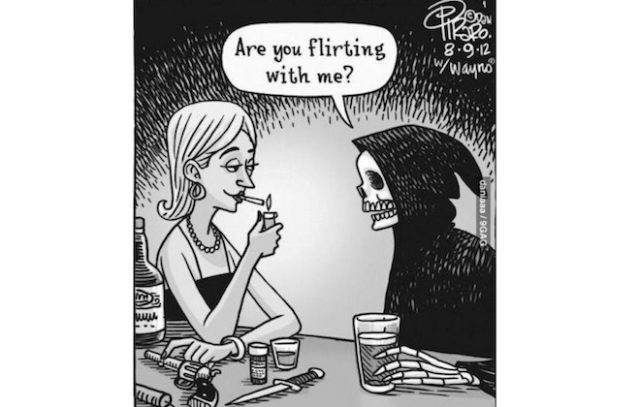ONE OF THE THINGS that strikes me whenever I spend time with people in their 90’s is how full their lives have been! They have simply been able to experience far more than those who didn’t make it that far. The rest of us have got to try to get there too.
Of course, there is all the usual boring stuff that I don’t need to go into. These include keeping our waistlines in check, which means exercising, and putting down our mobile phones when driving and walking. Turning to smoking, a graph of U.S. survivorship says it all. Smokers move themselves onto a black-diamond ski slope that really starts to descend steeply after age 60. As most smokers started as high school students, 40 years of smoke inhalation is about all the body can take.
Moving on to drinking, a fairly new medical finding is the effect of regular drinking on elevating stroke risk. While a drink or two a day generally decreases stroke risk, the effect is U-shaped. Raise the level to four drinks a day, and the stroke risk rises (a composite medical study here is reviewed by Nicholas Bakalar in the New York Times “Well” column, Nov. 23, 2016).
The mechanism appears to be alcohol’s effect on thinning the blood. At modest levels, the slightly thinned blood flows better. At higher levels, however, particles adhering to the walls of blood vessels tend to pull loose and flow with the blood, where they can relodge in the fine blood vessels of the brain (an ischemic stroke, the most common kind). I am reminded of my college chemistry, where alcohol pulls into solution organic molecules that are normally not water-soluble.
Alcohol runs through the human experience. Scientific studies tell us that the enzymes for digesting alcohol have been present in humans since our distant ancestors first began eating rotten fruit, and found that there was something about it that they liked.
Alcohol became a part of the Japanese-American community because the Issei first immigrated as single men. Given societal prejudices, language differences, anti- miscegenation laws, and personal inclinations, there was little that they could do socially but drink with their male friends across their first decade. From their Issei fathers, the Nisei men also learned to drink. While less prevalent among my Sansei peers, we too are human, and many of us enjoy a drink or two with friends at week’s end. Yet the slope is a slippery one.
Do not get me started on the smoking and drinking habits of the Japanese! The two years I lived in Japan were the most smoke-veiled and alcohol fueled of my entire life. How many times did I see gorgeous “campaign girls” vamping free sample packs of cigarettes at festivals? Was it every week that I walked into restaurants where the air was solid smoke, or threaded my way between inebriated businessmen on trains? What would the Japanese lifespan be without these vices? At 83.7 years, it is already ranked #1 in the world by the World Health Organization (2015). This is because they have figured out the diet and exercise aspects. Please join me in taking it easy on the various nonessential substances out there, so that thirty years from now, we can all revisit this column, and laugh.




